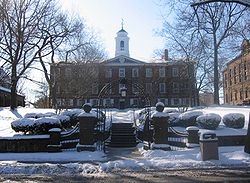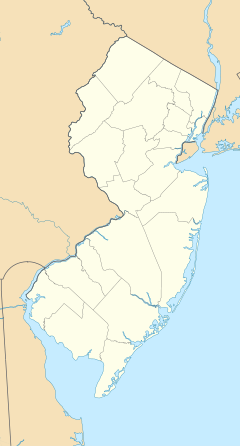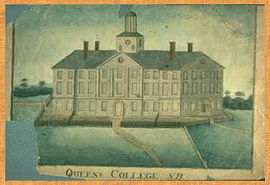- Old Queens
-
Old Queen's
 Winter at Old Queen's, the oldest building at Rutgers, built between 1809-1825.
Winter at Old Queen's, the oldest building at Rutgers, built between 1809-1825.Location: New Brunswick, New Jersey Coordinates: 40°29′57.72″N 74°26′50.88″W / 40.4993667°N 74.4474667°WCoordinates: 40°29′57.72″N 74°26′50.88″W / 40.4993667°N 74.4474667°W Built: 1808 Architect: McComb,John,Jr. Architectural style: Federal Governing body: State NRHP Reference#: 76001164[1] Significant dates Added to NRHP: May 11, 1976 Designated NHL: May 11, 1976[2] Old Queens is the oldest building at Rutgers, The State University of New Jersey in New Brunswick, New Jersey (USA) and the seat of the university's administration. Designed by noted architect John McComb, Jr., Old Queens is regarded by architectural experts as one of the finest examples of Federal architecture. Old Queens was placed on the National Register of Historic Places on 11 May 1976 and is listed as a National Historical Landmark.[3][4]
The surrounding city block is known as Old Queens Campus. This block is bound by Somerset Street to the east, George Street (north), College Avenue (south) and Hamilton Street (west), and contains several of the university's oldest buildings.
By metonymy, Old Queens came to be used to refer to Rutgers College, and then the university.
Contents
History
The Old Queens campus is rife with history dating several years before the construction of the Old Queens building. During the American Revolution, Alexander Hamilton commanded a battery of artillery which fired upon British positions under the command of William Howe, 5th Viscount Howe to provide time for General George Washington to escape south through New Brunswick in early December 1776 following the fall of New York City.
The heirs of John Parker, a merchant and prominent individual from Perth Amboy donated a 5-acre (20,000 m2) apple orchard to Queen's College in 1808. This tract of land would become the Old Queens campus.[5]
Old Queens was designed by John McComb, Jr. (1763-1853) a noted architect who designed the Hamilton Grange (1802) in Harlem for Alexander Hamilton, Castle Clinton (1808) on Lower Manhattan's Battery Park (1808), and the New York City Hall (1803).
Named after Queen's College, the original name of Rutgers College, the cornerstone for Old Queens was laid on 27 April 1809 by Reverend Ira Condict, the college's third president.[6][7] The Queen for whom Queen's College was named, was Charlotte of Mecklenburg-Strelitz (1744–1818), the Queen-consort of King George III who was on the throne of the United Kingdom when Queen's College was founded in 1766. Due to the young college's financial difficulties, the building was not completed until 1825.[6][7] Classes began within the completed portions of the building as early as 1811 for Queen's College (now Rutgers University), Queen's College Grammar School (now Rutgers Preparatory School), and the New Brunswick Theological Seminary. The New Brunswick Theological Seminary moved in 1856 to a new 7 acre (28,000 m²) campus less than one-half mile away, as a result of overcrowding. The Grammar School had moved across the street several years earlier in 1830.[6][7]
In 1825, Colonel Henry Rutgers, an American Revolutionary War Hero and philanthropist from New York City gave the fledgling Queens College a $5,000 bond and a bell. The Trustees renamed the institution in honor of Colonel Rutgers.[6][7] The bell, known as the Old Queens Bell, was hung in the cupola of Old Queens to chime the passing of classes.[6] It remains there today, and is rung on special occasions, such as at Commencement exercise in May and in recognition of athletic teams who have won national conferences.[8] The cupola was donated by Stephen Van Rensellaer in 1825.[7]
Initially, the first floor of Old Queens served as classrooms where recitation was held, and the second floor housed the college's chapel and library. The wings on each side of the structure served as living quarters for the faculty of the College. At the time, with no dormitories (until 1890), students at Rutgers found housing within rooming houses and other off-campus locations throughout New Brunswick.[7]
Today, Old Queens houses the offices of the university president and other top administration.
The gate outside Old Queens is the subject of a Rutgers legend. It is said that a Rutgers student should only walk through the gate on two days: convocation and graduation. One who passes through the gate on any other day during his/her undergraduate studies is said to be doomed to stay for an extra year.[citation needed]
Architecture
Constructed of ashlar brownstone in the front and sides and of local field stone in the rear, the façade of Old Queens incorporates symmetry and balance typical of Federal style architecture, and classical motifs such as Doric pilasters, and low-height pediments (or tympanum or gables) resembling those on ancient Greek and Roman temples typical to the Early American period.
Old Queens boasts its original handmade glass windowpanes. The lower floor windows are 12x8, with 16x12 on the second and 12x12 third floors. In each of the gables, circular windows, typical to Federal architecture are present.
A cupola erected in 1825, topped by a weathervane, houses the Old Queens Bell donated by Colonel Henry Rutgers.
Old Queens Campus
The Old Queens Campus as a whole was recognized with inclusion on the National Register of Historic Places in 1973.
Other buildings neighboring Old Queens on the Old Queens Campus, presently include or previously included:
President's House (1841, demolished 1948 in a hurricane)
Van Nest Hall (1845)
Daniel S. Schanck Observatory (1865)
Geology Hall (1872)
Kirkpatrick Chapel (1873)
Winants Hall (1890)The Old Queens campus is accessed through four gateways, the Henry Rutgers Baldwin Gateway (erected 1901) on College Avenue, named for Henry Rutgers Baldwin (Class of 1849), the Class of 1883 Memorial Gateway (erected in 1904) at the corner of George and Somerset Streets, the Class of 1882 Gateway (erected 1907) at the corner of Somerset Street and College Avenue, and the Class of 1902 Memorial Gateway (erected in 1904) on Hamilton Street leading to the Voorhees Mall and the academic buildings on Rutgers University's College Avenue Campus. It is through this last gate that graduating seniors walk during Commencement exercises in May.[7]
Located in front of Old Queens, the Class of 1877 Cannon commemorates both the Rutgers-Princeton Cannon War and several alumni who have served in the United States military. As a tradition during commencement, those graduating break clay pipes over the cannon as a symbol of breaking ties with the memories of times of camaraderie and fellowship had during their undergraduate years.
References
- ^ "National Register Information System". National Register of Historic Places. National Park Service. 2007-01-23. http://nrhp.focus.nps.gov/natreg/docs/All_Data.html.
- ^ "Old Queens, Rutgers University". National Historic Landmark summary listing. National Park Service. 2008-06-23. http://tps.cr.nps.gov/nhl/detail.cfm?ResourceId=-1633&ResourceType=Building.
- ^ National Register of Historic Places - List of sites in Middlesex County, New Jersey accessed 10 September 2006.
- ^ National Park Service: National Historical Landmarks Program accessed 10 September 2006.
- ^ Alumni Relations Newsletter
- ^ a b c d e "Rutgers Through the Years Timeline". Rutgers University. http://ruweb.rutgers.edu/timeline/. Retrieved 2006-09-10.
- ^ a b c d e f g "Paths to Historic Rutgers: A Self-Guided Tour". Rutgers University. http://www.libraries.rutgers.edu/rul/libs/scua/university_archives/historic_ru_paths.shtml. Retrieved 2006-09-10.
- ^ Tradition at www.scarletknights.com, accessed on 10 September 2006.
Books and printed materials
- Demarest, William Henry Steele. History of Rutgers College: 1776-1924. (New Brunswick, NJ: Rutgers College, 1924).
- History of Rutgers College: or an account of the union of Rutgers College, and the Theological Seminary of the General Synod of the Reformed Dutch Church. Prepared and published at the request of several trustees of the College, by a trustee. (New York: Anderson & Smith, 1833).
- McCormick, Richard P. Rutgers: a Bicentennial History. (New Brunswick, NJ: Rutgers University Press, 1966).
- Schmidt, George P. Princeton and Rutgers: The Two Colonial Colleges of New Jersey. (Princeton, NJ: Van Nostrand, 1964).
External links
U.S. National Register of Historic Places Topics Lists by states Alabama • Alaska • Arizona • Arkansas • California • Colorado • Connecticut • Delaware • Florida • Georgia • Hawaii • Idaho • Illinois • Indiana • Iowa • Kansas • Kentucky • Louisiana • Maine • Maryland • Massachusetts • Michigan • Minnesota • Mississippi • Missouri • Montana • Nebraska • Nevada • New Hampshire • New Jersey • New Mexico • New York • North Carolina • North Dakota • Ohio • Oklahoma • Oregon • Pennsylvania • Rhode Island • South Carolina • South Dakota • Tennessee • Texas • Utah • Vermont • Virginia • Washington • West Virginia • Wisconsin • WyomingLists by territories Lists by associated states Other Categories:- Rutgers University
- American architecture
- National Historic Landmarks in New Jersey
- Buildings and structures completed in 1825
- Buildings and structures in Middlesex County, New Jersey
Wikimedia Foundation. 2010.


